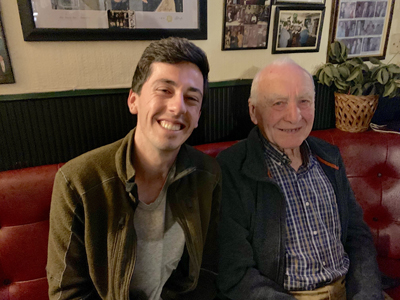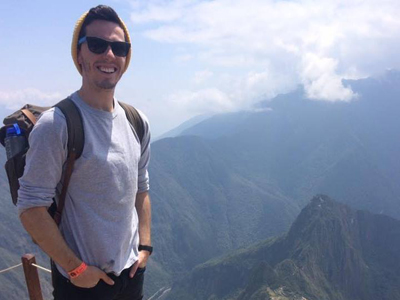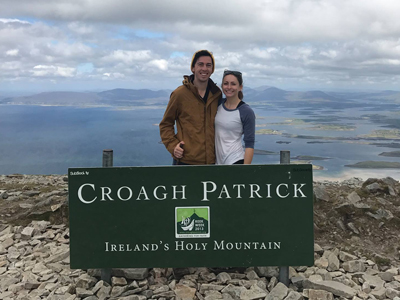
June 28, 2021
Imagine if every lab had an expert engineer to design microfluidic chips tailored to research specifications. Using rapid prototyping and machine learning to simplify the systematic design of droplet microfluidic platforms, the idea becomes a reality for one lab thanks to support from the 2021 SLAS Graduate Education Fellowship Grant.
On the last night of a summer internship, David McIntyre spent a quiet evening packing. He could have been lab-bound, engaging in brief stints of pipetting to complete his research, but instead, McIntyre programmed advanced cloud technology and robotic support to do the lab work for him. He simply checked his smartphone for an email notification with results and continued preparing to return to his final year of undergraduate studies.
In that moment, McIntyre made a pivot in his future plans as he discovered the power of automation when placed in the hands of researchers. The forward-thinking cloud technology he used during his internship at Transcriptic (now Strateos, Menlo Park, CA, USA) inspired him to further define his studies from leveraging technology to improve global health to using it to simplify bioengineering to help other researchers achieve their goals. Now as a Ph.D. candidate in biomedical engineering in the lab of Douglas Densmore, Ph.D., at Boston University (BU, Boston, MA, USA), McIntyre has expanded a software and hardware stack from Densmore’s lab that will efficiently and reproducibly specify, design and fabricate microfluidic devices through automation.
“What led me to Doug’s lab was the desire to simplify and accelerate the manual processes most researchers use to answer questions in the lab. I needed to determine first what researchers want to achieve and then develop an application to fulfill it,” says McIntyre.
“Typically you need a microfluidics engineer to build a device,” he continues. “It’s a long, artisanal process that we hope to turn into more of a plug-and-chug practice.” With the support of the $100,000 SLAS Graduate Education Fellowship Grant, awarded over two years, McIntyre will demonstrate the potential of machine-guided droplet microfluidics to build novel applications that can be repurposed for other processes including optimizing biomanufacturing and high-throughput drug screening.
Densmore is excited about what the grant will make possible for McIntyre’s work. “He is an entrepreneurial innovator who will be the bridge to biology in our lab and will fully integrate the knowledge he acquires into our microfluidic and electronic platforms,” comments Densmore, who is impressed with McIntyre’s mature approach to graduate research. Densmore says that many undergraduate and Ph.D. students struggle because “they are used to homework, but the trick about homework is that someone already knows the answer. In research, we’re seeking the answers. Life sciences discovery and technology holds a lot of ambiguity and that’s something David deals with well.”
Densmore further comments that the SLAS grant will allow research independence. “The SLAS grant removes some of the financial and planning burdens for both the student and the professor. It’s like managing a small business with a budget and objectives to meet goals,” he concludes.
McIntyre agrees. “The SLAS grant gives researchers freedom to explore areas related to their primary research without the constraints imposed by other types of funding. It provides money for my stipend, purchases for experiments, such as equipment or reagents, and other educational expenses – including travel to conferences when the COVID-19 pandemic concludes,” he comments. “The great thing about SLAS compared to a government or school fellowship is being supported by an entire community. You get a lot of meaningful exposure to individuals and companies that stand behind the work you are doing.”
Machine-Guided Droplet Microfluidics
McIntyre describes Densmore’s lab as the perfect intersection of biology and engineering to complete his Ph.D. work. Densmore set up the Cross-disciplinary Integration of Design Automation Research (CIDAR) lab at BU after earning a Ph.D. in electrical engineering at the University of California, Berkeley (UC Berkeley, Berkeley, CA, USA), to apply electronic design automation to biological design.
“Doug’s postdoctoral work focused on creating the same type of automation for biology that you might find in smart phone technology development. Fifty or 60 years ago, people were doing those processes by hand,” McIntyre says. “This is how we want to automate microfluidic design, fabrication and testing. To get something that complex into that small of a footprint, you need fairly sophisticated software tools.”
McIntyre’s preliminary work includes helping develop a machine-learning design automation tool for microfluidics called DAFD, which gathers user-generated datasets to map design parameters to device performance using trained neural networks (NNs) to predict droplet size and generation rate.
“For example, if you need 50-micron droplets made at 100 per second, or if you want to inject 10 percent of the droplets’ volume at 20 per second – you can specify that design using our platform instead of designing it yourself,” explains McIntyre, adding that transfer learning makes DAFD easily extensible. Its models can be extended to predict behavior for different reagents, fabrication methods or other microfluidic components.
Moving forward, McIntyre will expand the DAFD tool using active machine learning that algorithmically requests training data from the user, simplifying the data generation process. Data generation is further simplified through a rapid and affordable fabrication workflow he co-created using desktop computer-numerical-control (CNC) micromilling and off-the-shelf conductive ink for electronic integration. Using this, he can build functional components for droplet sorting, sensing, merging and picoinjection. The speed and low cost of this workflow make it ideal to generate training data for machine learning models. His further plans include extending the DAFD tool for multicomponent design automation and reaction condition optimization within the microfluidic device.
However, McIntyre notes, “No tool is useful unless you can prove its applications. I think that getting a robust process in which you can generate data and run experiments is fundamental to making research reproducible. Someone can publish a paper and it can be the world’s next best thing, but if no one can use it and you can’t prove it actually works, what’s the point?”
To make certain that there was a purpose for his current technology, McIntyre and a few other members of the Densmore lab went through the intensive I-Corps FUSION program, sponsored the Massachusetts Institute of Technology and National Science Foundation (MIT, NSF, Boston, MA, USA), to explore commercial potential for automated microfluidics device design. MIT offered funding to travel to a conference of their choice to conduct face-to-face interviews with potential customers of their technology.
“We chose to go to SLAS2020 because of its unique combination of industry and academic members – something we couldn’t find at many other conferences,” McIntyre comments, adding that the team targeted and made appointments ahead of time with a few companies, but primarily relied on working the exhibition floor.
“It was a great experience! We were able to access a breadth of people, from established automation companies and start-up businesses to academics,” he reports. “Our goal was to do 15 interviews and we ended up with 29.”
These interactions further guided his plan to use DAFD’s hardware and software platform to build a proof-of-concept. His plans include working with the principal investigators of three groups at BU to apply these high-throughput screens to generate environmental biosensors. “These sensors, with built-in biological memory, will show what we can do with this technology,” he comments.
"Constructing such a device could take the entire length of a Ph.D. program to complete,” McIntyre continues. “Rather than having someone do all that manual work, our lab generates a combinatorial library with loads of different possible biosensor candidates. Then using the components, we can put it through our hardware system to specify and easily change parameters to create high-performing devices.”
The biosensors, according to Densmore, offer both internal and external benefits. From what goes on around us to biochemical signals that go on inside us, biosensors can shape and improve our daily lives – from detecting negative impacts from hazards and toxins or positive changes such as the moisture level of soil, to sensing the optimal time for fertility or minimizing disease impact from diabetes.
“Electronics can't measure everything biological, and we don't necessarily want those in our bodies, so we make biosensors and tailor them to detect certain things,” Densmore explains. “Imagine that you had a field in a developing country where land mines were still present. If you could scatter seeds over that space that changed color in response to the presence of land mine, for example, that could improve life and agriculture in that region.”
Hands-On Experience
With the feedback gained from his onsite interviews at SLAS2020, McIntyre returned to BU and launched into shaping his work. But shortly after he returned to campus, the COVID-19 pandemic turned the world upside down. Faced with three months of a shelter-in-place order that suspended most of his Ph.D. work, McIntyre found he had to get creative to maintain his focus and purpose.
From the end of March through the end of May, like many others, he didn’t go into the lab at all. Instead, he destressed by improving his long-distance running – he ran a solo, unsupported marathon – and expanded his coding skills with online tutorials.
“I knew how to code for the most part through my undergraduate degree, but I didn’t have the core computational part to my thesis. What I proposed to do – using active machine learning models to extend DAFD – I developed during the lockdown,” he says, describing how he powered through a coding course in a week’s time. “It probably wasn’t the best way to do it, but I didn’t want to pay for anything beyond a free trial!” he says with a laugh.
Then, starting in June, a unique opportunity emerged – contributing to the automation aspect of BU’s COVID testing facility on campus. “My first day back on campus was June 1, and by August 1 of that summer we had the entire lab built out and began testing students. Since then we have run 1,000,000+ tests. Everyone on the BU campus gets tested weekly, and this includes contact tracing and quarantine tracking as well. It has kept BU running,” he says.
McIntyre notes that while his contribution to the facility didn’t change anything in his research, it did become a big part of his Ph.D. journey. “It was nice to contribute my automation knowledge and skills to something tangible, to be part of a team where I have a set role and to see that impact so quickly,” he comments.
McIntyre’s ability to step into this role was due in part to his undergraduate volunteer experience with the University of Washington Chapter of the Engineers without Borders - USA (EWB - USA), a non-profit humanitarian organization that partners with developing communities worldwide. “EWB - USA is focused on civil engineering and development projects,” says McIntyre, who is constantly looking for ways to contribute his energy and talent. “Although it didn’t focus on bioengineering, it was the quickest way I could use engineering to build out projects that could help other people.”
His EWB - USA experiences included constructing a water delivery system for communities in Nicaragua and building a community center in Guatemala, among others. “I got a lot of hands-on experience – I poured concrete, directed projects, managed budgets and organized fundraising galas,” says McIntyre, who also joined fellow students to lobby for class credit that recognized their hours of volunteer work. The effort resulted in a special topics class that is still available to students three years later.
“If you only conduct research and follow the traditional pipeline to get into graduate school, you’ll find yourself there with the technical abilities, but you might miss out on developing the personal and organizational management skills required to succeed,” McIntyre comments. “Some of the experiences I acquired were completely outside the realm of technical research and unrelated to what I was doing, but it developed important soft skills that have helped me throughout graduate school and my Ph.D. journey.”



Sidelines
From Art Form to Practice: Listen to the SLAS New Matter Podcast as David McIntyre Explains His Work
Gain Exposure for Your Work! Submit Your Research to the SLAS2022 Student Poster Competition
Your Ticket to the Heart of SLAS! Apply Today for Tony B. Academic Travel Awards
